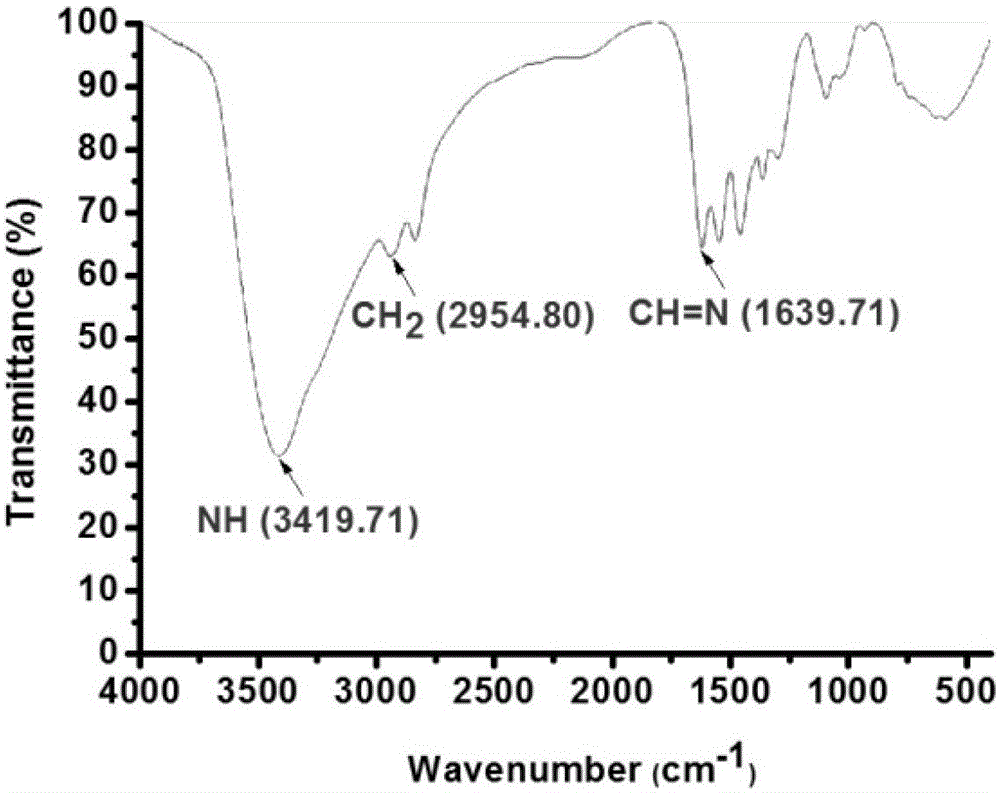Carrier of nucleic acid substance containing degradable imine bond, its preparation method and application
A technology of imine bonds and nucleic acid drugs, applied in other methods of inserting foreign genetic materials, genetic material components, pharmaceutical formulations, etc., can solve problems such as reduced transfection efficiency, general transfection activity, and escape of nucleic acid substances, and achieve vector The effect of simple structure, low cytotoxicity and high transfection activity
- Summary
- Abstract
- Description
- Claims
- Application Information
AI Technical Summary
Problems solved by technology
Method used
Image
Examples
Embodiment 1
[0049] Preparation of carrier (PPI) of nucleic acid substance containing degradable imine bond
[0050] Synthetic route such as figure 1 shown. Specifically include the following steps:
[0051] (1) The reaction solvent is absolute ethanol, add anhydrous magnesium sulfate to absolute ethanol and let stand for 48 hours, then distill to obtain fresh absolute ethanol for later use; the whole reaction is carried out in an anhydrous and oxygen-free (high-purity nitrogen protection) environment , take the molar ratio of small molecule PEI (Mw=800Da) and imidazole dialdehyde as 1:2.5, dissolve small molecule PEI and imidazole dialdehyde respectively with absolute ethanol, and make 20mL and 50mL solutions respectively;
[0052] (2) Add the imidazole dialdehyde solution to the small molecule PEI solution drop by drop with a constant pressure dropping funnel, and stir the reaction system at room temperature to allow a condensation reaction to occur for 24 hours;
[0053] (3) After ...
Embodiment 2
[0067] Preparation of PPI and pDNA complexes
[0068] Weigh a certain amount of polymer PPI and dissolve it in ultrapure water with a concentration of 2.0mg / mL, and filter it through a 0.45μm microporous membrane for use; draw a certain amount of pDNA solution and dilute it with ultrapure water to form a 20μg / mL pDNA stock solution . When preparing the PPI-pDNA complex, dilute the PPI solution to the corresponding concentration according to the set mass ratio of a series of PPI and pDNA, and then quickly add it to the pDNA solution of the same volume and constant concentration (the final concentration of pDNA is 2 μg / mL ), finally gently pipetting, mixing evenly, and incubating at room temperature for 20-30 minutes to obtain a series of complex solutions with different mass ratios for further characterization of physical and chemical properties.
Embodiment 3
[0070] Agarose gel electrophoresis of complexes of PPI and pDNA
[0071] Weigh 1.0 g of agarose, add 100 mL of 1×TAE buffer solution, heat and dissolve in a microwave oven, wait until the temperature drops to 65 °C, add 4 μL of ethidium bromide (EB) to prepare a 1.0% agarose solution (containing 0.5 μg / mL ethidium bromide), pour it into the glue tank, insert the sample comb, and leave it at room temperature for 0.5-1 hour to solidify into glue. Then, pull out the sample comb, add TAE buffer to the electrophoresis tank to submerge the gel slightly, and wait for the sample to be loaded. Next, compound solutions with different mass ratios were prepared according to the preparation method of the compound, and the compound mass ratios were 0, 0.5, 1, 3, 5, 10, 20, 30, and 50 in sequence. Marker chooses DS TM 5000 (100–5000bp), load 5 μL of sample; 1 μL of 6× sample buffer (bromophenol blue-glycerol indicator, containing 0.25% bromophenol blue, 40% glycerol) is evenly mixed with...
PUM
| Property | Measurement | Unit |
|---|---|---|
| pore size | aaaaa | aaaaa |
| pore size | aaaaa | aaaaa |
| particle diameter | aaaaa | aaaaa |
Abstract
Description
Claims
Application Information
 Login to View More
Login to View More - R&D Engineer
- R&D Manager
- IP Professional
- Industry Leading Data Capabilities
- Powerful AI technology
- Patent DNA Extraction
Browse by: Latest US Patents, China's latest patents, Technical Efficacy Thesaurus, Application Domain, Technology Topic, Popular Technical Reports.
© 2024 PatSnap. All rights reserved.Legal|Privacy policy|Modern Slavery Act Transparency Statement|Sitemap|About US| Contact US: help@patsnap.com










